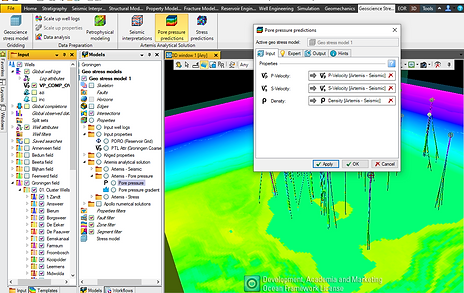Petrel
POC (Proof of Concept) Project

Industry: Energy Industry, Gas & Oil
Company: SLB (Schlumberger)
Type: 3-month Summer Internship, 2024
(Confidential Work)
Data analysis and data visualization: I can show it only in request since the project was confidential.
Project Type
Our project was to create a POC (Proof of Concept) for investment in Petrel, the largest gas and oil exploration software.
Importance: Petrel is the major revenue source for SLB. So, the project was real work, rather than just an internship project.
The Team
We were a multidisciplinary team, consisting of a software engineer, a UX designer, and a product designer.
Together we were responsible for:
-
Emphasizing the critical need for investing in Petrel software.
-
Showing stakeholders how:
→ Do the right thing (product quality)
→ Do the thing right (process quality)
My Role
I was carrying a strategic product designer role. That means taking a high-level approach and blending design with business strategy, rather than focusing on only the product's design and user experience.
So, I was responsible for understanding user needs, balancing them with business goals, and creating the product roadmap together with developers and the high-management team, data analysis and transforming complex data into simple and clear insights to act on.
For that, I did user research and benchmark analysis, and designed several design systems: one focusing on user needs, one focusing on business strategy, and one new pragmatic idea with UX designer. Then, facilitated workshops to align the developers, PM, QA, and managers for the project goals. Collaborating with the software engineer teammate we built the usability test. I conducted usability tests to test these design systems with internal users (because of confidentiality), interviewed them, and analyzed test data with the UX designer teammate. Then, I used data to inform desicisions and provided results and insights to the development and management team, focusing on the product’s long-term vision and business impact.
I played a key role in convincing stakeholders to secure the 2025 budget for this project.
Tools
Figma, Mural, and Phyton (for A/B Test), JAsp (Quantitative Data Analysis Tool), Excel
Purpose of the Project
-
Emphasizing the critical need for investing in Petrel software.
-
Showing stakeholders how:
→ Do the right thing (product quality)
→ Do the thing right (process quality)
Goal: Convincing stakeholders to invest in Petrel.
Background
What is Petrel & Why does it need investment?
Petrel is a 25-year-old software used in gas and oil exploration, in high-stakes environments. It has around 37 million lines of code —so complex that no one wants to mess with it. Any mistake could cost millions of dollars per day.
-
But it’s outdated and needs modernization to stay competitive and be usable for the next generation of workers.
-
Right now, there’s a big gap between experienced users and new ones trying to learn it.
Introduction
Risk of the project
Without timely investment, SLB risks losing millions of dollars as competitors who have already modernized pull ahead of them. The cost of not acting was high, and the opportunity to stay competitive was low.
But where should SLB start?
Project Process Part 1:
Design Thinking
We were initially recruited as UI designers, but as interns, we quickly recognized the importance of following the design thinking process. This shifted the project’s focus to exploring the right problem and identifying the best solution. As a result, we adjusted the project plan with our managers and higher management team and shared the UX design, UX research, UI design, and programming roles based on our skills and interests.
Project Process Part 2:
Align Business Strategy with User Needs
By following the design thinking method, the priority of the project changed. We identified the user needs, business needs, challenges, and risks. Then, we described the problem statement. It was not a linear process but rather iterative and we spent around 2-3 weeks on it.
New Plan:
1. Modernize
Updating to current standards
Ex: Pixels to Vector
Ex: WinForms to WPF
2. Streamline
Making the process efficient
Ex: Using the company's cloud system for the same experience
3. Innovate
Introducing new technologies
Ex: Integrate AI, ML to workflows
Looking ahead to the long-term business plan, if we are aiming to integrate GenAI ML workflows into Petrel, which would be a significant innovation, we FIRST need to STREAMLINE our existing processes.
This includes creating CONSISTENT experiences.
However, before we can streamline effectively, we must UPDATE Petrel to current standards, which means MODERNIZATION. The goal of modernization is IMPROVING EXPERIENCE and QUALITY by ALIGNING the software with current technologies. That includes the transition from pixels to vectors for ICONS; to do so we need to make a transition between the TOOLS: from Photoshop to Figma.
That's why prioritizing the modernization phase TODAY is ESSENTIAL for SLB’s long-term success.
But where should we start to modernize?
Start from Icon Library
Subtle but impactful
It's because this change, while subtle, keeps the software familiar yet impactful enough to give the UI a fresh, modern, and updated appearance.
PS: There are other strong reasons but I can't share because of confidentiality.
RISK
If we DON'T modernize
Risk losing millions of $
→ It risks customers switching to other software
If we DO modernize
Risk losing millions of $ daily
→ Minor change = Alters the meaning of the icons
Challenge: Two Type of Users
If we DON'T modernize
Risk losing millions of $
Future User
Frustrations:
→ Outdated user interface (UI)
→ Inconsistencies
Needs:
→ Intuitive
→ Customization
If we DO modernize
Risk losing millions of $ daily
Aging User
Frustrations:
→ Major updates
→ Inconsistencies
Needs:
→ Gradual transition
→ Familiar UI

Project Challenges
User needs vs Business strategy
→ Contrasting user needs
Technical Challenges
→ Development
→ Test Tools for usability
Problem:
How much can we push the modernization?
Problem Statement:
How to modernize Petrel's iconography to be attractive while upkeeping users’ satisfaction?
Method:
Design Thinking Process
UX process is naturally based on design thinking.
→ Identify the right problem from the beginning to get the right solution.
→ Put the user, in the center from the beginning, in every stage.
Project Process Part 3:
Competitor Analysis
User Feedback
Design Alternatives
We made a benchmark analysis and looked into our competitors, together with reading customer feedback on each update on the software version. That helped us to design alternatives. For some alternatives, we prioritized user needs, and for some business strategies. We also had several pragmatic alternatives, but we were not sure if they addressed to user needs.
Project Process Part 4:
Usability Tests
So, we didn't know which direction to go.
As UX designers, we don't like to assume.
Therefore, we put the usability tests in place.
Challenge:
Since the project and work were confidential, it required a lot of back-and-forth permissions from the higher management in different countries for the usability test tools.
Solution:
We decided to build our own test tool. Since we were a cross-disciplinary team we could put our expertise together: programming, coding, usability test (A/B, eye-tracking) expert, UI expert. Also, we could get help from our colleagues in Oslo, France, and the USA.
Project Process Part 5:
Test Tool
We needed to build our own tool for the usability tests because for approval on security and financial considerations. We created A/B tests, and attractiveness tests.
Disadvantages:
-
We lost 2-3 weeks to build, where we could spend this time on more testing and further iterations.
Advantages:
-
It was custom and targeted, meaning: We could test and analyze exactly what we wanted.
-
It was time-saving. Because of security issues:
-
Getting approval for the 3rd party tool (in the market) could take so long.
-
We needed to test on our local company computers.
-
We couldn't make it an online application because of the bureaucracy, and financial considerations.
-
We couldn't use the Teams and share a screen, because our measurements didn't work well with online tools, and the results could be biased.
-

Credits to our Guide: Emmanuelle Boloix, PhD, Senior UX Researcher and Architect
Results, Part 1
We used a mixed-method approach, meaning gathered both quantitative and qualitative data and analyzed them. The results cannot be shared due to confidentiality. However, we got valuable results, which helped us to design the next steps.
Quantitative
Data gathering: Usability tests
Analysis: Excel, Jasp
Qualitative
Data gathering: Interviews and transcript notes
Analysis: Thematic analysis
Results, Part 2
-
We shared our insights with higher management and stakeholders and got feedback.
-
We created a demo with working prototypes.
-
We created the one-year plan suggested to our company (SLB).
-
We presented it to stakeholders and our company across the world, and 178 people joined our final POC presentation.
Results, Part 3
-
We succeed in convincing stakeholders to invest in Petrel software.
-
We saved the 2025 budget for the company.
-
2 out of 3 of us received job offers, and our other teammate received a collaboration offer for her thesis.
Confidential
The project was confidential, therefore I respect that and can not share the details, results, any visual from the software, or data visualization here. — but I’d be happy to discuss it further in person.
Reflection
Went well
→ Participation in our usability tests
→ Guidance, support, collaboration
Could be better
→ Order effect in A/B tests
→ Thematic analysis (time)
Challenges
→ Test tools (approval)
→ Number of participants (holiday time)
I learned
→ How to be pragmatic
→ Proactive & problem-solving mindset
→ Being adaptable to sudden changes
→ Prioritizing correctly
-
I really enjoyed the cross-disciplinary collaboration and learned a lot from them.
-
I think we were such a lucky international and multi-disciplinary team who were open-minded, patient, kind, easy to communicate with, supportive, and feedback-oriented. We supported each other's growth, and in the end, we saw 1+1=3. I am so glad to work with them.
-
I truly found my internship valuable where I could figure out my weaknesses in UX and could get the opportunity to focus on them thanks to my mentors, managers, and team members.


